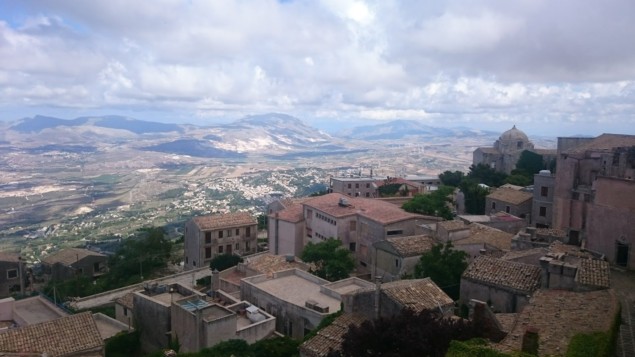
Poor planning on my part and a missed connection meant my travel from Somerset in the UK to the 2018 International Science Journalism School in Erice, Sicily, took a staggering 34 hours. It was already feeling like a pilgrimage when I finally landed in Sicily, but on the last leg by car our final destination came into view to give a hint as to why Erice is such a special place – the ancient town perched atop a mountain was enchantingly shrouded from prying eyes by its very own cloud, the only one in an otherwise clear blue sky.
With its own micro-climate and historical religious significance, an “Erice pilgrimage” may have been a thought that flashed through some of the greatest scientific minds in modern history, given my host for the summer school – the Ettore Majorana Foundation and Centre for Scientific Culture – was founded in 1963 by eminent fundamental physicists to foster ‘science without secrets and without frontiers’. The organization has since attracted dozens of Nobel Prize winners and other titans of physics.
While the likes of Paul Dirac and Richard Feynman were likely hammering out the finer details of quantum theory during their time in Erice, I along with 34 other writers, YouTubers, editors and science communicators of varying flavours had converged on the town to understand how to convey tomorrow’s complex fundamental physics to different audiences.
A hi-tech lecture theatre in the bowels of a converted church was our place of worship for the next four days. For those wanting an update on the latest gravity wave news or what the Large Hadron Collider is doing “post-Higgs”, they got it by the bucketload from Marica Branchesi (Virgo Collaboration) and Guy Wilkinson (LHCb experiment). For others keen to develop their media skills, the likes of Robin McKie from the Observer newspaper and Mario Tedeschini Lalli shared their experiences.
But most inspiring for me was a session by independent award-winning writer Jacopo Pasotti detailing his methods in reportage for the likes of National Geographic, Science and Wired. Having exposed illegal mining in the most biodiverse parts of the Amazon and uncovered hidden science stories that shine a light on tragedies such as the Banda Aceh tsunami, Pasotti was the perfect person to offer a “how-to” guide for any reporter or writer wanting to go beyond regurgitating news – and instead make a difference.
Equally thought-provoking were many of the attendees, whose opinions on the challenges science journalism currently faces in terms of hype, monetizing digital journalism and the role of the journalist in an increasingly crowded media landscape were intelligent and eye-opening during the interactive sessions.

Gin and ingenuity in Ireland
But as with any conference or school, the best stories are told during the coffee breaks. During one of these I got the chance to speak to a young Law student from Ukraine called Daria Zaremba. Her passion for science and frustration at the lack of science reporting in Ukrainian media has led her and a clutch of like-minded students to build PIDZEMKA, the country’s first science-communication digital platform. Meeting people like Daria made my Erice pilgrimage extra special – her determination to report science that informs and inspires the public in the face of overwhelming challenges is a lesson all science journalists should heed.



